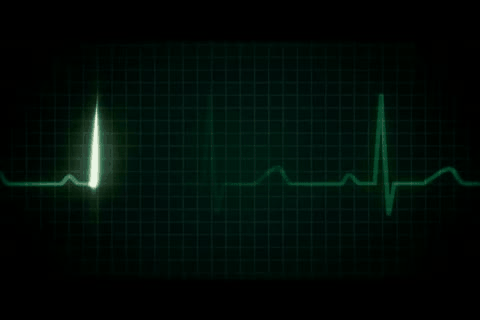THE CARDIAC CONDUCTION OF HUMAN HEART:
The normal electrical conduction in the heart allows the impulse that is generated by the sinoatrial node (SA node) of the heart to be propagated to (and stimulate) the cardiac muscle (myocardium). The myocardium contracts after stimulation. It is the ordered stimulation of the myocardium that allows efficient contraction of the heart, thereby allowing blood to be pumped throughout the body.Signals arising in the SA node stimulate the atria to contract and travel to the AV node. After a delay, the stimulus is conducted through the bundle of His to the Purkinje fibers and the endocardium at the apex of the heart, then finally to the ventricular epicardium.
On the microscopic level, the wave of depolarization propagates to adjacent cells via gap junctions located on the intercalated disk. The heart is a functional syncytium (not to be confused with a true "syncytium" in which all the cells are fused together, sharing the same plasma membrane as in skeletal muscle). In a functional syncytium, electrical impulses propagate freely between cells in every direction, so that the myocardium functions as a single contractile unit. This property allows rapid, synchronous depolarization of the myocardium. While advantageous under normal circumstances, this property can be detrimental, as it has potential to allow the propagation of incorrect electrical signals. These gap junctions can close to isolate damaged or dying tissue, as in a myocardial infarction.
VALVES CONTRACTING AND RELAXATION DUE TO THE ELECTRICAL CONDUCTION
VIDEO:
Images:
Requirements for effective pumping:
In order to maximize efficiency of contraction and cardiac output, the conduction system of the heart has:- Substantial atrial to ventricular delay. This will allow the atria to completely empty their contents into the ventricles; simultaneous contraction would cause inefficient filling and backflow. The atria are electrically isolated from the ventricles, connected only via the AV node which briefly delays the signal.
- Coordinated contraction of ventricular cells. The ventricles must maximize systolic pressure to force blood through the circulation, so all the ventricular cells must work together.
- Ventricular contraction begins at the apex of the heart, progressing upwards to eject blood into the great arteries. Contraction that squeezes blood towards the exit is more efficient than a simple squeeze from all directions. Although the ventricular stimulus originates from the AV node in the wall separating the atria and ventricles, the Bundle of His conducts the signal to the apex.
- Depolarization propagates through cardiac muscle very rapidly. Cells of the ventricles contract nearly simultaneously.
- The action potentials of cardiac muscle are unusually sustained. This prevents premature relaxation, maintaining initial contraction until the entire myocardium has had time to depolarize and contract.
- Absence of tetany. After contracting, the heart must relax to fill up again. Sustained contraction of the heart without relaxation would be fatal, and this is prevented by a temporary inactivation of certain ion channels.
- Cardiac muscle has some similarities to neurons and skeletal muscle,
as well as important unique properties. Like a neuron, a given
myocardial cell has a negative membrane potential when at rest. Stimulation above a threshold value induces the opening of voltage-gated ion channels and a flood of cations into the cell. The positively charged ions entering the cell cause the depolarization characteristic of an action potential. Like skeletal muscle, depolarization causes the opening of voltage-gated calcium channels and release of Ca2+ from the t-tubules. This influx of calcium causes calcium-induced calcium release from the sarcoplasmic reticulum, and free Ca2+ causes muscle contraction. After a delay, Potassium channels reopen and the resulting flow of K+ out of the cell causes repolarization to the resting state.
Note that there are important physiological differences between nodal cells and ventricular cells; the specific differences in ion channels and mechanisms of polarization give rise to unique properties of SA node cells, most important, the spontaneous depolarizations necessary for the SA node's pacemaker activity.
THANK YOU..!!








No comments:
Post a Comment